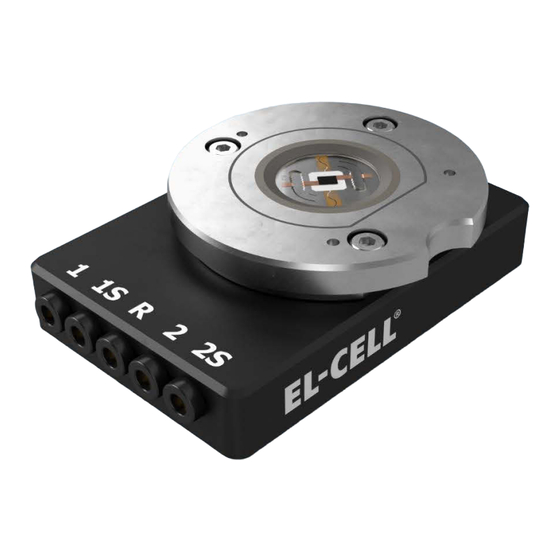Summary of Contents for EL-CELL ECC-Opto-10
- Page 1 User Manual Release 1.00 ECC-Opto-10 Electrochemical test cell © 2021 EL-Cell GmbH...
- Page 2 The information in this manual has been carefully checked and believed to be accurate; however, no responsibility is assumed for inaccuracies. EL-Cell GmbH maintains the right to make changes without further notice to products described in this manual to improve reliability, function, or design. EL -Cell GmbH does not assume any liability arising from the use or application of this product.
-
Page 3: Table Of Contents
5 Assembly ..........................7 6 Connecting the test cell ...................... 12 7 Disassembly and Cleaning ....................13 8 Unpacking ..........................13 9 Components ECC-Opto-10 ....................14 10 Technical Support ......................16 11 Warranty ..........................16 Page 3 of 16 Release 1.00... -
Page 4: Product Description
Raman spectroscopy in reflection mode. The ECC-Opto-10 is connected to the battery tester via 2 mm cell cable with banana plugs. It can be used with the PAT-Tester-x-8 as well as potentiostats and battery testers from third - party manufacturers. - Page 5 User Manual ECC-Opto-10 Working principle of the ECC-Opto-10 (side-by-side setup of electrodes): Inspection area (up to 18 mm) Sapphire glass window Electrode 2 Electrode 1 Lid sealing (PE) Sample holder Plunger Glass fiber separator Inner sleeve II Compression spring Electrode 1 pin...
-
Page 6: Technical Data
Electrode R diameter: <= 10 mm 3 Intended use The ECC-Opto-10 test cell is an electrochemical measuring instrument designed for use in a laboratory environment. It may only be used by trained personnel and only as described in this manual. -
Page 7: Assembly
User Manual ECC-Opto-10 5 Assembly Generally, all assembly steps are to be carried out in inert glove box atmosphere . All components used are to be dried upfront in a vacuum oven at 80°C for at least 12 hours. Once fully assembled, the cell is hermetically sealed so that it may be operated in ambient atmosphere. - Page 8 User Manual ECC-Opto-10 3. Insert the window thrust ring. 4 Attach the window flange and screw in the screws using the torque screwdriver 0.2 Nm. 5. Insert the lower piston into the inner sleeve. 6. Use the loading tweezer to push the piston into the sleeve.
- Page 9 User Manual ECC-Opto-10 7. Place the assembly into the cell base. 8. Insert the sample holder into the loading tweezers. 9. Squeeze the tweezer together to lift the sample holder bracket. Then attach the first electrode strip to the sample holder.
- Page 10 User Manual ECC-Opto-10 11. Put the electrode R, lithium metal in this case, on top of the piston. 12. Put the separator on top. The separator must not be more than 10 mm in diameter. A smaller separator may be useful to prevent the sample holder from coming into contact with the electrolyte.
- Page 11 User Manual ECC-Opto-10 15. Insert the second foil seal. 16. Drop the electrolyte onto the separator / electrodes. Use only the amount of electrolyte necessary to impregnate the porous material. Avoid an excess of electrolyte. Typically, less than 50 µl of electrolye is suitable. Note that electrolyte will be squeezed out of the separator when the cell lid is attached.
-
Page 12: Connecting The Test Cell
User Manual ECC-Opto-10 19. The ECC-Opto-10 is now ready for testing. 6 Connecting the test cell Connect your potentiostat to the 2 mm sockets of the cell. Note that sockets 1 and 1S are short-circuited inside the cell housing, as are sockets 2 and 2S. -
Page 13: Disassembly And Cleaning
Contact the factory if anything is missing or damaged. NOTE: Damaged shipments must remain with the original packaging for freight company inspection. List of Components: ECC-Opto-10 test cell with flat socket, fully equipped for use in both 2-electrode and 3- electrode configuration Windows seal (10 pcs.) ECC1-05-0016-B/X Separator 10.0 mm x 0.26 mm, GF/A (10 pcs.) -
Page 14: Components Ecc-Opto-10
User Manual ECC-Opto-10 9 Components ECC-Opto-10 ECC-Opto-10 Page 14 of 16 Release 1.00... - Page 15 User Manual ECC-Opto-10 Lid (OPTO-10) 18 mm, assy Page 15 of 16 Release 1.00...
-
Page 16: Technical Support
11 Warranty For a period of one year from the date of shipment, EL-Cell GmbH (hereinafter Seller) warrants the goods to be free from defect in material and workmanship to the original purchaser. During the warranty period, Seller agrees to repair or replace defective and/or nonconforming goods or parts without charge for material or labor, or, at the Seller’s option, demand return...













Need help?
Do you have a question about the ECC-Opto-10 and is the answer not in the manual?
Questions and answers